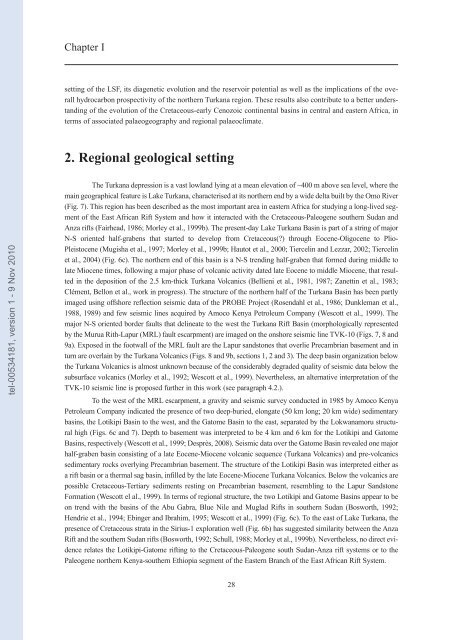Etude stratigraphique, pétrographique et diagénétique des grès d ...
Etude stratigraphique, pétrographique et diagénétique des grès d ...
Etude stratigraphique, pétrographique et diagénétique des grès d ...
Create successful ePaper yourself
Turn your PDF publications into a flip-book with our unique Google optimized e-Paper software.
tel-00534181, version 1 - 9 Nov 2010<br />
Chapter I<br />
s<strong>et</strong>ting of the LSF, its diagen<strong>et</strong>ic evolution and the reservoir potential as well as the implications of the overall<br />
hydrocarbon prospectivity of the northern Turkana region. These results also contribute to a b<strong>et</strong>ter understanding<br />
of the evolution of the Cr<strong>et</strong>aceous-early Cenozoic continental basins in central and eastern Africa, in<br />
terms of associated palaeogeography and regional palaeoclimate.<br />
2. Regional geological s<strong>et</strong>ting<br />
The Turkana depression is a vast lowland lying at a mean elevation of ~400 m above sea level, where the<br />
main geographical feature is Lake Turkana, characterised at its northern end by a wide delta built by the Omo River<br />
(Fig. 7). This region has been <strong>des</strong>cribed as the most important area in eastern Africa for studying a long-lived segment<br />
of the East African Rift System and how it interacted with the Cr<strong>et</strong>aceous-Paleogene southern Sudan and<br />
Anza rifts (Fairhead, 1986; Morley <strong>et</strong> al., 1999b). The present-day Lake Turkana Basin is part of a string of major<br />
N-S oriented half-grabens that started to develop from Cr<strong>et</strong>aceous(?) through Eocene-Oligocene to Plio-<br />
Pleistocene (Mugisha <strong>et</strong> al., 1997; Morley <strong>et</strong> al., 1999b; Hautot <strong>et</strong> al., 2000; Tiercelin and Lezzar, 2002; Tiercelin<br />
<strong>et</strong> al., 2004) (Fig. 6c). The northern end of this basin is a N-S trending half-graben that formed during middle to<br />
late Miocene times, following a major phase of volcanic activity dated late Eocene to middle Miocene, that resulted<br />
in the deposition of the 2.5 km-thick Turkana Volcanics (Bellieni <strong>et</strong> al., 1981, 1987; Zan<strong>et</strong>tin <strong>et</strong> al., 1983;<br />
Clément, Bellon <strong>et</strong> al., work in progress). The structure of the northern half of the Turkana Basin has been partly<br />
imaged using offshore reflection seismic data of the PROBE Project (Rosendahl <strong>et</strong> al., 1986; Dunkleman <strong>et</strong> al.,<br />
1988, 1989) and few seismic lines acquired by Amoco Kenya P<strong>et</strong>roleum Company (Wescott <strong>et</strong> al., 1999). The<br />
major N-S oriented border faults that delineate to the west the Turkana Rift Basin (morphologically represented<br />
by the Murua Rith-Lapur (MRL) fault escarpment) are imaged on the onshore seismic line TVK-10 (Figs. 7, 8 and<br />
9a). Exposed in the footwall of the MRL fault are the Lapur sandstones that overlie Precambrian basement and in<br />
turn are overlain by the Turkana Volcanics (Figs. 8 and 9b, sections 1, 2 and 3). The deep basin organization below<br />
the Turkana Volcanics is almost unknown because of the considerably degraded quality of seismic data below the<br />
subsurface volcanics (Morley <strong>et</strong> al., 1992; Wescott <strong>et</strong> al., 1999). Nevertheless, an alternative interpr<strong>et</strong>ation of the<br />
TVK-10 seismic line is proposed further in this work (see paragraph 4.2.).<br />
To the west of the MRL escarpment, a gravity and seismic survey conducted in 1985 by Amoco Kenya<br />
P<strong>et</strong>roleum Company indicated the presence of two deep-buried, elongate (50 km long; 20 km wide) sedimentary<br />
basins, the Lotikipi Basin to the west, and the Gatome Basin to the east, separated by the Lokwanamoru structural<br />
high (Figs. 6c and 7). Depth to basement was interpr<strong>et</strong>ed to be 4 km and 6 km for the Lotikipi and Gatome<br />
Basins, respectively (Wescott <strong>et</strong> al., 1999; Desprès, 2008). Seismic data over the Gatome Basin revealed one major<br />
half-graben basin consisting of a late Eocene-Miocene volcanic sequence (Turkana Volcanics) and pre-volcanics<br />
sedimentary rocks overlying Precambrian basement. The structure of the Lotikipi Basin was interpr<strong>et</strong>ed either as<br />
a rift basin or a thermal sag basin, infilled by the late Eocene-Miocene Turkana Volcanics. Below the volcanics are<br />
possible Cr<strong>et</strong>aceous-Tertiary sediments resting on Precambrian basement, resembling to the Lapur Sandstone<br />
Formation (Wescott el al., 1999). In terms of regional structure, the two Lotikipi and Gatome Basins appear to be<br />
on trend with the basins of the Abu Gabra, Blue Nile and Muglad Rifts in southern Sudan (Bosworth, 1992;<br />
Hendrie <strong>et</strong> al., 1994; Ebinger and Ibrahim, 1995; Wescott <strong>et</strong> al., 1999) (Fig. 6c). To the east of Lake Turkana, the<br />
presence of Cr<strong>et</strong>aceous strata in the Sirius-1 exploration well (Fig. 6b) has suggested similarity b<strong>et</strong>ween the Anza<br />
Rift and the southern Sudan rifts (Bosworth, 1992; Schull, 1988; Morley <strong>et</strong> al., 1999b). Nevertheless, no direct evidence<br />
relates the Lotikipi-Gatome rifting to the Cr<strong>et</strong>aceous-Paleogene south Sudan-Anza rift systems or to the<br />
Paleogene northern Kenya-southern Ethiopia segment of the Eastern Branch of the East African Rift System.<br />
28

















